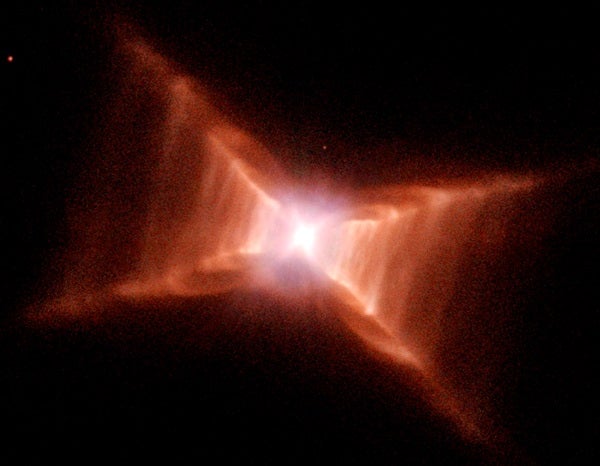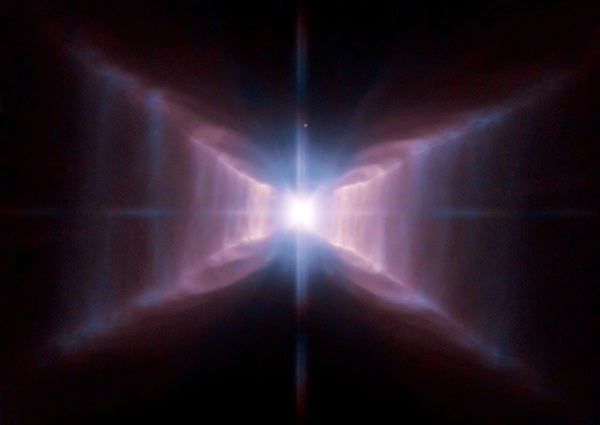The Red Rectangle Nebula doesn’t merely look modern-art cubist bizarre. Its very light is strange, its composition is food for philosophy, and it remains a hot venue of current research.
Located in the constellation Monoceros the Unicorn, its central 9th-magnitude binary star was discovered in 1915 by the famous double-star hunter Robert Grant Aitken. Things changed in 1973 when a rocket-borne infrared sky survey discovered the ruddy nebula surrounding the binary, soon labeled HD 44179 after the star’s catalog designation. It took years, and better instrumentation, including studies performed by the Hubble Space Telescope, to fully reveal how odd and intriguing is this dusty gas cloud 2,300 light-years away.
The first head-twister is immediately obvious. In a universe of vast swirling curves, where celestial straight lines are almost nonexistent and geometric shapes the stuff of dreams, we stare at a giant rectangle. Or perhaps it’s more like a squared-off bow tie or a woven “God’s eye.” Or maybe it’s a giant X with interconnected ladder-like steps. However you see it, the question remains: Why should gem-like symmetry materialize in an enormous gaseous nebula?
Then there’s its color. Spectrographs detect glowing hydrogen — the normal hum-drum white-bread emissions of nebulae everywhere. But here it’s diluted and dominated by a different shade of orange-red given off by glowing dust. Dust fluorescing? The dust in our homes thankfully doesn’t glow, and neither does the celestial variety. Physicists are only recently homing in on its composition, and it’s not what they expected.
Astronomers call this nebula’s alien illumination Extended Red Emission, or ERE. It was first discovered in 1975 right here in the Red Rectangle, and has since been observed elsewhere, even in other galaxies. It has been a mystery for more than 30 years. The odd glow is always associated with dust bathed in ultraviolet light, as well as with a kind of photoluminescence or afterglow. Researchers think complex carbon-rich molecules called polycyclic aromatic hydrocarbons (PAHs) are responsible for the ERE.
PAHs are always fascinating. You bite into them after you’ve overcooked your burger. You get a face full when you drive too closely behind a diesel truck. They are released during the burning of fossil fuel. And here they are in the Red Rectangle, including anthracene and pyrene, organic molecules vital for the formation of life. The big problem is that the same ultraviolet light that makes these PAHs glow should quickly destroy them. However, recent thinking says the thick dusty shielding surrounding the binary stars blocks the “hardest” ultraviolet (UV) emissions, allowing these complex organic hydrocarbons to remain intact, helped by newly discovered molecular forces that preserve them.
So the Red Rectangle’s odd glow is probably explained. But what about its odd shape? The cause of some of HD 44179’s features is still mysterious. But in 1981, a team led by Dutch astronomer Vincent Icke showed that the overall formation could result when spherical gas ejections from the binary stars produce odd shock waves after hitting an unusually thick doughnut dust-ring. This could create two outflows shaped like ice cream cones whose points meet in the middle. Thus, the giant X would be these two cones seen edgewise.
As for the intermediate ladder-like connections, which make the whole thing resemble a spider web, they could be places where eruptions deposited extra material every few hundred years. These straight features resemble no other nebula in the universe, although the recently found “Red Square” nebula does look somewhat like a skimpier, lower-cost version. In any case, the “rungs” could be expanding structures, which NASA/ESA describe as shaped like “wine glasses, seen exactly edge-on so that their rims appear as straight lines.”
In 2009, a Red Rectangle report in The Astrophysical Journal said that the central binary stars orbit each other every 319 days. One is a normal hot star and not a white dwarf as previously believed. It pulls off material at 300 miles (500 km) per second from its cool red companion, a star that weighs the same as our Sun. The pair’s highly eccentric orbit yanks off far more material when the two are closest together about once a year. When this cool mass-losing star collapses into a sizzling blue dwarf sometime in the next few thousand years, the UV flux will crank way up and then the whole shebang will glow as a planetary nebula.
So HD 44179 is a protoplanetary. Its material comes from matter lost by one star and directed away by its companion into a bipolar configuration that is squeezed and channeled by a thick dust ring. Its oddly colored light is probably the glow of organic molecules.
The Red Rectangle is thus a historic entity whose unique shape and singular glow opened doors to previously unknown phenomena. Still enigmatic in some ways, its newly solved mysteries will continue creating beautiful structures — and, eventually, perhaps life itself.











